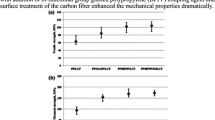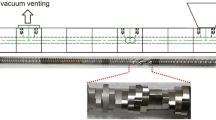Abstract
Natural fibers are limited in their use as reinforcement to commodity polymers. They cannot be used to reinforce engineering polymers due to their low thermal stability at high processing temperatures. This study presents an approach to successfully reinforce polyamides using a derivative of natural fibers as reinforcement without the effects of thermal degradation during melt processing. Biocarbon from miscanthus fibers was used to reinforce polyamide 6 up to 40 wt%. At 40 wt% filler content, the tensile and flexural strengths increased by 19.6 and 47% respectively in comparison to the neat polyamide. The moduli were also increased by 31.5 and 63.7% respectively. A maximum increase in impact strength of 43.7% was achieved at 20 wt% biocarbon loading. The morphology of the tensile fractured samples showed stretched polyamide ligaments attached to the biocarbon particles, indicating the presence of interaction between filler and matrix. Interestingly, more bonded interfaces were observed between the polyamide and biocarbon particles with increasing biocarbon content possibly stemming from increased biocarbon surfaces with functional groups. These composites show great potential to substitute in part or whole, some particulate filled polyamides currently used in the automotive industry.










Similar content being viewed by others
References
Stewart R (2010) Automotive composites offer lighter solutions. Reinf Plast 54:22–28. https://doi.org/10.1016/S0034-3617(10)70061-8
Mohanty AK, Misra M, Drzal LT (2001) Surface modifications of natural fibers and performance of the resulting biocomposites: an overview. Compos Interfaces 8:313–343. https://doi.org/10.1163/156855401753255422
Li X, Tabil LG, Panigrahi S (2007) Chemical treatments of natural fiber for use in natural fiber-reinforced composites: a review. J Polym Environ 15:25–33. https://doi.org/10.1007/s10924-006-0042-3
Bledzki A (1999) Composites reinforced with cellulose based fibres. Prog Polym Sci 24:221–274. https://doi.org/10.1016/S0079-6700(98)00018-5
Ichazo M, Albano C, González J, Perera R, Candal M (2001) Polypropylene/wood flour composites: treatments and properties. Compos Struct 54:207–214. https://doi.org/10.1016/S0263-8223(01)00089-7
Štrumberger N, Gospočić A, Hvu M, Bartulić Č (2005) Polymeric materials in automobiles. Promet Traffic Traffico 17:149–160. https://doi.org/10.7307/ptt.v17i3.630
Mohanty A, Tummala P, Misra M, Drzal L (2009) Filler reinforced thermoplastic compositions and process for manufacture. US Pat 7:582,241 2
Elsabbagh A, Steuernagel L, Ring J (2017) Natural Fibre/PA6 composites with flame retardance properties: extrusion and characterisation. Compos B Eng 108:325–333. https://doi.org/10.1016/j.compositesb.2016.10.012
Garcia-Ramirez M, Cavaillé JY, Dupeyre D, Péguy A (1994) Cellulose-polyamide 66 blends. I. Processing and characterization. J Polym Sci B Polym Phys 32:1437–1448. https://doi.org/10.1002/polb.1994.090320815
Vold JL, Ulven CA, Chisholm BJ (2014) Torrefied biomass filled polyamide biocomposites: mechanical and physical property analysis. J Mater Sci 50:725–732. https://doi.org/10.1007/s10853-014-8632-2
Collard FX, Blin, J (2014) A review on pyrolysis of biomass constituents: mechanisms and composition of the products obtained from the conversion of cellulose, hemicelluloses and lignin. Renew Sustain Energy Rev 38:594–608. https://doi.org/10.1016/j.rser.2014.06.013
Kan T, Strezov V, Evans TJ (2016) Lignocellulosic biomass pyrolysis: a review of product properties and effects of pyrolysis parameters. Renew Sustain Energy Rev 57:126–1140
Lehmann J, Joseph S; Biochar for Environmental Management: Science, Technology and Implementation, Chapt. 4, Biochar production technology, Boateng AA, Garcia-Perez M, Masek O, Brown R, del Campo B pp 63–88, 2nd edn., Earthscan from Routledge
Behazin E, Ogunsona E, Rodriguez-Uribe A, Mohanty AK, Misra M, Anyia AO (2016) Mechanical, chemical, and physical properties of wood and perennial grass biochars for possible composite application. BioResources 11:1334–1348. https://doi.org/10.15376/biores.11.1.1334-1348
Behazin E, Misra M, Mohanty AK (2017) Sustainable biocarbon from pyrolyzed perennial grasses and their effects on impact modified polypropylene biocomposites. Compos B Eng 118:116–124. https://doi.org/10.1016/j.compositesb.2017.03.003
Salak F, Uemura S, Sugimoto K (2015) Thermal pretreatment of kudzu biomass (pueraria lobata) as filler in cost-effective pla biocomposite fabrication process. Polym Eng Sci 55:340–348. https://doi.org/10.1002/pen.23909
Qian S, Sheng K, Yao W, Yu H (2016) Poly(lactic acid) biocomposites reinforced with ultrafine bamboo-char: Morphology, mechanical, thermal, and water absorption properties. J Appl Polym Sci. https://doi.org/10.1002/app.43425
Peterson SC, Chandrasekaran SR, Sharma BK (2016) Birchwood biochar as partial carbon black replacement in styrene-butadiene rubber composites. J Elastomers Plast 48:305–316. https://doi.org/10.1177/0095244315576241
Jong L, Peterson SC, Jackson MA (2014) Utilization of porous carbons derived from coconut shell and wood in natural rubber. J Polym Environ 22:289–297. https://doi.org/10.1007/s10924-013-0637-4
Peterson SC (2011) Evaluating corn starch and corn stover biochar as renewable filler in carboxylated styrene-butadiene rubber composites. J Elastomers Plast 44:43–54. https://doi.org/10.1177/0095244311414011
Peterson S (2013) Utilization of low-ash biochar to partially replace carbon black in styrene–butadiene rubber composites. J Elastomers Plast 45:487–497. https://doi.org/10.1177/0095244312459181
Das O, Sarmah AK, Bhattacharyya D (2016) Biocomposites from waste derived biochars: mechanical, thermal, chemical, and morphological properties. Waste Manag 49:560–570. https://doi.org/10.1016/j.wasman.2015.12.007
Ahmetli G, Kocaman S, Ozaytekin I, Bozkurt P (2013) Epoxy composites based on inexpensive char filler obtained from plastic waste and natural resources. Polym Compos 34:500–509. https://doi.org/10.1002/pc.22452
Richard S, Rajadurai JS, Manikandan V (2016) Influence of particle size and particle loading on mechanical and dielectric properties of biochar particulate-reinforced polymer nanocomposites. Int J Polym Anal Charact 21:462–477. https://doi.org/10.1080/1023666X.2016.1168602
Sri Aprilia N, Khalil H, Bhat A, Dungani R, Hossain M (2014) Exploring material properties of vinyl ester biocomposites filled carbonized jatropha seed shell. BioResources 9:4888–4898
Ojha S, Acharya SK, Raghavendra G (2015) Mechanical properties of natural carbon black reinforced polymer composites. J Appl Polym Sci. https://doi.org/10.1002/app.41211
Ogunsona EO, Misra M, Mohanty AK (2017) Impact of interfacial adhesion on the microstructure and property variations of biocarbons reinforced nylon 6 biocomposites. Compos A Appl Sci Manuf 98:32–44
Ogunsona EO, Misra M, Mohanty AK (2017) Sustainable biocomposites from biobased polyamide 6,10 and biocarbon from pyrolyzed miscanthus fibers. J Appl Polym Sci 134:44221. https://doi.org/10.1002/app.44221
Ogunsona EO, Misra M, Mohanty AK (2017) Accelerated hydrothermal aging of biocarbon reinforced nylon biocomposites. Polym Degrad Stab 139:76–88. https://doi.org/10.1016/j.polymdegradstab.2017.03.013
Ogunsona EO, Misra M, Mohanty AK (2017) Influence of epoxidized natural rubber on the phase structure and toughening behavior of biocarbon reinforced nylon 6 biocomposites. RSC Adv 7:8727–8739. https://doi.org/10.1039/C6RA27177D
Chrissafis K, Bikiaris D (2011) Can nanoparticles really enhance thermal stability of polymers? Part I: an overview on thermal decomposition of addition polymers. Thermochim Acta 523:1–24. https://doi.org/10.1016/j.tca.2011.06.010
Xenopoulos A, Wunderlich B (1990) Heat capacities of solid polyamides. Polymer 31:1260–1268. https://doi.org/10.1016/0032-3861(90)90217-M
Achhammer BG, Reinhart FW, Kline GM (1951) Mechanism of the degradation of polyamides. J Res Natl Bur Stand 46:391. https://doi.org/10.6028/jres.046.044
Dabrowski F, Bourbigot S, Delobel R, Le Bras M (2000) Kinetic modelling of the thermal degradation of polyamide-6 nanocomposite. Eur Polym J 36:273–284. https://doi.org/10.1016/S0014-3057(99)00079-8
Amintowlieh Y, Sardashti A, Simon LC (2012) Polyamide 6-wheat straw composites: degradation kinetics. Polym Compos 33:985–989. https://doi.org/10.1002/pc.22229
Lahijani P, Zainal ZA, Mohamed AR, Mohammadi M (2013) CO2 gasification reactivity of biomass char: catalytic influence of alkali, alkaline earth and transition metal salts. Bioresour Technol 144:288–295. https://doi.org/10.1016/j.biortech.2013.06.059
Mani S, Kastner JR, Juneja A (2013) Catalytic decomposition of toluene using a biomass derived catalyst. Fuel Process Technol 114:118–125. https://doi.org/10.1016/j.fuproc.2013.03.015
Zhang ZZ, Zhu MM, Liu PF, Wan WC, Zhou WX, Chan YL, Zhang DK (2015) Effect of biochar on the cracking of tar from the pyrolysis of a pine sawdust in a fixed bed reactor. Energy Procedia 75:196–201. https://doi.org/10.1016/j.egypro.2015.07.299
Dabrowski F, Bourbigot S, Delobel R, Le Bras M (2000) Kinetic modelling of the thermal degradation. Eur Polym J 36:273–284. https://doi.org/10.1016/S0014-3057(99)00079-8
Ogunsona EO, Anstey J, Torres SE, Codou AMFM-S., Jubinville DF (2018) Biocarbon and nylon based hybrid carbonaceous biocomposites and methods of making those and using thereof. US Application Patent: US20180022921A1
Nuñez A, Sturm P, Kenny J, Aranguren M, Marcovich N, Reboredo M (2003) Mechanical characterization of polypropylene–wood flour composites. J Appl Polym Sci 88:1420–1428
Ahmed S, Jones F (1990) A review of particulate reinforcement theories for polymer composites. J Mater Sci 25:4933–4942
Liu Z (2002) Effects of coupling agent and morphology on the impact strength of high density polyethylene/CaCO3 composites. Polymer 43:2501–2506. https://doi.org/10.1016/S0032-3861(02)00048-4
Huber T, Misra M, Mohanty AK (2014) The effect of particle size on the rheological properties of polyamide 6/biochar composites. In AIP Conference Proceedings; Cleveland, Ohio, USA p. 150004
Acknowledgements
The authors acknowledge the financial support by the Ontario Ministry of Agriculture, Food and Rural Affairs (OMAFRA) – University of Guelph Product Development and Enhancement through Value Chains Research Theme (Project # 200399, 200388, 200245), The Natural Sciences and Engineering Research Council (NSERC), Canada Discovery grant (Project # 400322) and Ontario Research Fund, Research Excellence Program; Round-7 (ORF-RE07) from the Ontario Ministry of Research and Innovation, currently known as the Ontario Ministry of Research, Innovation and Science (MRIS) (Project # 052644 and # 052665).
Author information
Authors and Affiliations
Corresponding author
Rights and permissions
About this article
Cite this article
Ogunsona, E.O., Codou, A., Misra, M. et al. Thermally Stable Pyrolytic Biocarbon as an Effective and Sustainable Reinforcing Filler for Polyamide Bio-composites Fabrication. J Polym Environ 26, 3574–3589 (2018). https://doi.org/10.1007/s10924-018-1232-5
Published:
Issue Date:
DOI: https://doi.org/10.1007/s10924-018-1232-5




